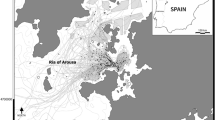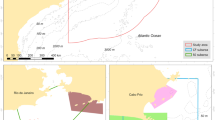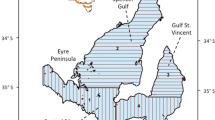Abstract
Owing to the worldwide growth of aquaculture over the last years, new habitats have been created through the supplement of nutrients. This addition of nutrients affects the whole marine food web, resulting in predator species such as bottlenose dolphins becoming attracted to these areas. During this 5-year-long study that was carried out along the north-eastern coast of Sardinia (Italy), bottlenose dolphin’s history of exposure to aquaculture perturbations and their effects was documented. The interaction with a fish farm was assessed by studying the site fidelity, group dynamics, and seasonal and yearly occurrence. In all, 1,838 hours were spent in the field. Behavioural observations showed that the predominant activity (89 % of the time) in the fish farm was foraging (predation and depredation). The occurrence of bottlenose dolphins appeared to be related with the seasons and with the fish farm harvesting operations. Thus, the peak dolphin occurrence in the fish farm area throughout Fall coincides with the period in which they spend most of their time foraging. A relatively small community remained resident interacting with the fish farm over a long period of time. Hence, these individuals gained intimate knowledge on how to capitalize on the fish farm industry. This heterogeneity in site fidelity and residence patterns is highly relevant when coastal management initiatives are considered.


Similar content being viewed by others
References
Altmann J (1974) Observational study of behaviour: sampling methods. Behaviour 49:227–267
Bearzi G, Fortuna CM, Reeves RR (2008) Ecology and conservation of common bottlenose dolphins Tursiops truncatus in the Mediterranean Sea. Mammal Review 39(2):92–123
Beveridge M (1996) Cage aquaculture, 2nd edn. Blackwell Science Ltd, Fishing News Books, Oxford
Black KD (2001) Environmental impacts of aquaculture. Sheffield Academic Press, Sheffield
Carss DN (1990) Concentrations of wild and escaped fishes immediately adjacent to fish farm cages. Aquaculture 90(1):29–40
Carss DN (1994) Killing of piscivorous birds at Scottish fish farms, 1984–87. Biol Conserv 68(2):181–188
Cole R (2002) Impacts of marine farming on wild fish populations. Final research report for ministry of fisheries research project ENV2000/08. National Institute of Water and Atmospheric Research, New Zealand
Connor RC, Wells RS, Mann J, Read AJ (2000) The bottlenose dolphin: social relationships in a fission-fusion society. In: Mann J, Connor R, Tyack PL, Whitehead H (eds) Cetacean societies: field studies of dolphins and whales. University of Chicago Press, Chicago, pp 91–126
Connor RC, Smolker R, Bejder L (2006) Synchrony, social behaviour and alliance affiliation in Indian Ocean bottlenose dolphins, Tursiops aduncus. Anim Behav 72:1371–1378
Dempster T, Sanchez-Jerez P, Bayle-Sempere J, Kingsford M (2004) Extensive aggregations of wild fish at coastal sea-cage fish farms. Hydrobiologia 525:245–248
Díaz López B (2006a) Bottlenose dolphin (Tursiops truncatus) predation on a marine fin fish farm: some underwater observations. Aquat Mamm 32:305–310
Díaz López B (2006b) Interactions between Mediterranean bottlenose dolphins (Tursiops truncatus) and gillnets off Sardinia, Italy. ICES J Mar Sci 63:946–951
Díaz López B (2009) The bottlenose dolphin Tursiops truncatus foraging around a fish farm: effects of prey abundance on dolphins’ behaviour. Current Zool 55(4):243–248
Díaz López B, Mariño F (2011) A trial of an acoustic harassment device efficacy on free-ranging bottlenose dolphins in Sardinia, Italy. Mar Freshw Behav Phys 44(4):197–208
Díaz López B, Shirai JAB (2007) Bottlenose dolphin (Tursiops truncatus) presence and incidental capture in a marine fish farm on the north-eastern coast of Sardinia (Italy). J Mar Biol Assess UK 87:113–117
Díaz López B, Shirai JAB (2008) Marine aquaculture and bottlenose dolphins’ (Tursiops truntatus) social structure. Behav Ecol Sociobiol 62(6):887–894
Díaz López B, Shirai JAB (2010) Mediterranean common bottlenose dolphin's repertoire and communication use. In: Pierce AG, Correa L (eds) Dolphins: Anatomy, Behavior, and Threats. Nova Science Publishers, New York, pp 129–148
Díaz López B, Marini L, Polo F (2005) The impact of a fish farm on a bottlenose dolphin population in the Mediterranean Sea. Thalassas 21:53–58
Díaz López B, Bunke M, Shirai JAB (2008) Marine aquaculture off Sardinia Island (Italy): ecosystem effects evaluated through a trophic mass-balance model. Ecol Model 212:292–303
FAO (1999) The state of world fisheries and aquaculture, 1998. Fisheries Department, Food and Agriculture Organization, Rome, Italy
FAO (2007) The state of world fisheries and aquaculture 2006. FAO Fisheries and Aquaculture Department. Food and agriculture organization of the United Nations, Rome, Italy
Fernandes TF, Eleftheriou A, Ackefors H, Eleftheriou M, Ervik A, Sanchez-Mata A, Scanlon T, White P, Cochrane S, Pearson TH, Miller KL, Read PA (2002) The management of the environmental impacts of aquaculture. Scottish Executive, Aberdeen
Fjälling A, Wahlberg M, Westerberg H (2006) Acoustic harassment devices reduce seal interaction in the Baltic salmon-trap, net fishery. ICES J Mar Sci 63:1751–1758
Giovanardi O (1990) I piccoli pelagici nel Mar Tirreno: Osservazioni dopo il primo anno di indagini ittioplanctoniche. Cuaderno ICRAP, Rome
Gowans S, Würsig B, Karczmarski L (2008) The social structure and strategies of delphinids: predictions based on an ecological framework. Adv Mar Biol 53:195–294
Hammond PS (1986) Estimating the size of naturally marked whale populations using capture-recapture techniques. Rep Int Whaling Comm Spec Issue 8:253–282
Hargrave BT (2003) Far-field environmental effects of marine finfish aquaculture. A scientific review of the potential environmental effects of aquaculture in aquatic ecosystems. Volume I. Can Tech Rep Fish Aquat Sci 2450:1–35
Kemper CM, Shaughnessay P, Pemberton D, Mann J, Hume F, Cawthorn M, Würsig B (2003) Aquaculture and marine mammals: coexistence or conflict? In: Gales N, Hindell M, Kirkwood R (eds) Marine mammals: fisheries, tourism and management issues. CSIRO Publishing, Victoria, pp 208–228
Lemarié G, Martin JLM, Dutto G, Garidou C (1998) Nitrogenous and phosphorous waste production in a flow-through land-based farm of European sea bass Dicentrarchus labrax. Aquat Living Resour 11:247–254
Machias A, Karakassis I, Giannoulaki M, Papadopoulou KN, Smith CJ, Somarakis S (2005) Response of demersal fish communities to the presence of fish farms. Mar Ecol-Prog Ser 288:241–250
Mann J, Sargeant B (2003) Like mother, like calf: the ontogeny of foraging traditions in wild Indian ocean bottlenose dolphins (Tursiops sp.). In: Fragazy DM, Perry S (eds) The biology of traditions: models and evidence. Cambridge University Press, Cambridge, pp 236–266
Mann J, Connor RC, Barre LM, Heithaus MR (2000) Female reproductive success in bottlenose dolphins (Tursiops sp.): life history, habitat, provisioning, and group-size effects. Behav Ecol 11:210–219
Morris DS (1996) Seal predation at salmon farms in Maine, an overview of the problem and potential solutions. Marine Technol Soc J 30(2):39–43
Nash CE, Iwamoto RN, Mahnken CVW (2000) Aquaculture risk management and marine mammal interactions in the Pacific Northwest. Aquaculture 183:307–323
Naylor RL, Goldburg RJ, Mooney H, Beveridge M, Clay J, Folke C, Kautsky N, Lubchenco J, Primavera J, Williams M (1998) Nature’s subsidies to shrimp and salmon farming. Science 282:883–884
Nowacek DP (2002) Sequential foraging behaviour of bottlenose dolphins, Tursiops truncatus, in Sarasota Bay, Florida. Behaviour 139:1125–1145
Olesiuk PF, Nichol LM, Sowden MJ, Ford JKB (2002) Effect of the sound generated by an acoustic harassment device on the relative abundance and distribution of harbor porpoises (Phocoena phocoena) in Retreat Passage, British Columbia. Mar Mamm Sci 18:843–862
Parra GJ, Corkeron PJ, Marsh H (2006) Population sizes, site fidelity and residence patterns of Australian snubfin and Indo-Pacific humpback dolphins: implications for conservation. Biol Conserv 129:167–180
Pillay TVR (1992) Aquaculture and the environment. Wiley, New York, NY
Pillay TVR (2004) Aquaculture and the environment, 2nd edn. Blackwell Publishing, Oxford
Price IM, Nickum JG (1995) Aquaculture and birds: the context for controversy. Col Waterbirds 18 (Special Publication 1):33–45
Read P, Fernandes T (2003) Management of environmental impacts of marine aquaculture in Europe. Aquaculture 226:139–163
Rendell L, Whitehead H (2001) Culture in whales and dolphins. Behav Brain Sci 24:309–342
Ross A (1988) Controlling nature’s predators on fish farms. Rep Mar Conserv Soc
Rueggeberg H, Booth J (1989) Interactions between wildlife and salmon farms in British Columbia: results of a survey. Technical Report Series, vol 67. Canadian Wildlife Service, Pacific and Yukon Region, British Columbia
Sargeant BL, Wirsing AJ, Heithaus MR, Mann J (2007) Can environmental heterogeneity explain individual foraging variation in wild bottlenose dolphins (Tursiops sp.)? Behav Ecol Sociobiol 61:679–688
Shane SH (1990) Comparison of Bottlenose Dolphin behaviour in Texas and Florida, with a critique of methods for studying dolphin behaviour. In: Leatherwood S, Reeves RR (eds) The bottlenose dolphin. Academic Press, San Diego, CA, pp 541–558
Watson-Capps JJ, Mann J (2005) The effects of aquaculture on bottlenose dolphin (Tursiops sp.) ranging in Shark Bay, Western Australia. Biol Conserv 124:519–526
Wiebe PH, Copley NJ, Boyd SH (1990) Coarse-scale horizontal patchiness and vertical migration of zooplankton in Gulf Stream warm-core ring 82-H. Deep-Sea Res 99:237–278
Williams JA, Dawson SM, Slooten E (1993) The abundance and distribution of bottlenose dolphins (Tursiops truncatus) in Doubtful Sound, New Zealand. Can J Zool 71:2080–2088
Wilson B, Hammond PS, Thompson PM (1999) Estimating size and assessing trends in a coastal bottlenose dolphin population. Ecol Appl 9(1):288–300
Wu RSS (1995) The environmental impact of marine fish culture: towards a sustainable future. Mar Pollut Bull 31(4–12):159–166
Würsig B, Gailey GA (2002) Responsible marine aquaculture. In: Stickney RR, McVay JP (eds) Marine mammals and aquaculture: conflicts and potential resolutions. CAP International Press, New York, pp 45–59
Würsig B, Jefferson RA (1990) Methods of photo-identification for small cetaceans. Rep Int Whaling Comm Spec Issue 12:43–52
Zar JH (1999) Biostatistical analysis. Prentice-Hall, Upper Saddle River, NJ
Acknowledgments
Funding for this research came from the Bottlenose Dolphin Research Institute—BDRI. This study would not have been possible without the willingness of the fish farm manager Dr. Graziano and fish farm workers, and I wish to thank them for their help and cooperation. Heartfelt thanks are extended to the BDRI member Selma Bajraktarevic who helped with the manuscript and all the volunteers and internships who gave generously of their time to help with field work. Data collection complies with the current laws of the country in which it was performed, Italy.
Author information
Authors and Affiliations
Corresponding author
Additional information
Communicated by U. Siebert.
Rights and permissions
About this article
Cite this article
López, B.D. Bottlenose dolphins and aquaculture: interaction and site fidelity on the north-eastern coast of Sardinia (Italy). Mar Biol 159, 2161–2172 (2012). https://doi.org/10.1007/s00227-012-2002-x
Received:
Accepted:
Published:
Issue Date:
DOI: https://doi.org/10.1007/s00227-012-2002-x




